The Impact of Urban Form on Carbon Emission Efficiency Under Public Transit-Oriented Development: Spatial Heterogeneity and Driving Forces
Abstract
1. Introduction
2. Literature Review
2.1. Land Use Type
2.2. Functional Composition
2.3. Transportation Structure
2.4. Spatial Layout
3. Materials and Methodology
3.1. Study Area
3.2. Carbon Emission Efficiency Calculation
3.3. Research Methodology and Analytical Framework
3.3.1. Indicator Construction and Data Processing
3.3.2. Modelling Framework
3.3.3. Ordinary Least Squares (OLS)
3.3.4. Geographically Weighted Regression (GWR)
3.3.5. Quantile Regression Model
4. Intra-Urban Disparities in Carbon Emission Efficiency Across Shenzhen
5. Analysis of the Factors Affecting the Carbon Emission Efficiency in Shenzhen
5.1. Comprehensive Evaluation of the Effects of the Urban Form on the Carbon Emission Efficiency
5.2. Geographically Weighted Evaluation of Urban Form’s Spatially Heterogeneous Effects on Carbon Emission Efficiency
5.2.1. Spatial Autocorrelation
5.2.2. Analysis of the Geographically Weighted Regression Results
5.3. Quantile-Varying Effects of Urban Form on Carbon Emission Efficiency Gradient
6. Conclusions and Policy Implications
Author Contributions
Funding
Data Availability Statement
Conflicts of Interest
References
- Luqman, M.; Rayner, P.J.; Gurney, K.R. On the Impact of Urbanisation on CO2 Emissions. NPJ Urban Sustain. 2023, 3, 6. [Google Scholar] [CrossRef]
- Clark, P.U.; Shakun, J.D.; Marcott, S.A.; Mix, A.C.; Eby, M.; Kulp, S.; Levermann, A.; Milne, G.A.; Pfister, P.L.; Santer, B.D.; et al. Consequences of Twenty-First-Century Policy for Multi-Millennial Climate and Sea-Level Change. Nat. Clim. Change 2016, 6, 360–369. [Google Scholar] [CrossRef]
- Li, B.; Gasser, T.; Ciais, P.; Piao, S.; Tao, S.; Balkanski, Y.; Hauglustaine, D.; Boisier, J.-P.; Chen, Z.; Huang, M.; et al. The Contribution of China’s Emissions to Global Climate Forcing. Nature 2016, 531, 357–361. [Google Scholar] [CrossRef]
- Shi, K.; Chen, Y.; Yu, B.; Xu, T.; Chen, Z.; Liu, R.; Li, L.; Wu, J. Modeling Spatiotemporal CO2 (Carbon Dioxide) Emission Dynamics in China from DMSP-OLS Nighttime Stable Light Data Using Panel Data Analysis. Appl. Energy 2016, 168, 523–533. [Google Scholar] [CrossRef]
- Azevedo, V.G.; Sartori, S.; Campos, L.M.S. CO2 Emissions: A Quantitative Analysis among the BRICS Nations. Renew. Sustain. Energy Rev. 2018, 81, 107–115. [Google Scholar] [CrossRef]
- Fu, B.; Li, B.; Gasser, T.; Tao, S.; Ciais, P.; Piao, S.; Balkanski, Y.; Li, W.; Yin, T.; Han, L. The Contributions of Individual Countries and Regions to the Global Radiative Forcing. Proc. Natl. Acad. Sci. USA 2021, 118, e2018211118. [Google Scholar] [CrossRef]
- Holden, P.B.; Edwards, N.R.; Ridgwell, A.; Wilkinson, R.D.; Fraedrich, K.; Lunkeit, F.; Pollitt, H.; Mercure, J.-F.; Salas, P.; Lam, A. Climate–Carbon Cycle Uncertainties and the Paris Agreement. Nat. Clim. Change 2018, 8, 609–613. [Google Scholar] [CrossRef]
- Li, J.; Zhang, D.; Su, B. The Impact of Social Awareness and Lifestyles on Household Carbon Emissions in China. Ecol. Econ. 2019, 160, 145–155. [Google Scholar] [CrossRef]
- Duan, H.; Zhou, S.; Jiang, K.; Bertram, C.; Harmsen, M.; Kriegler, E.; van Vuuren, D.P.; Wang, S.; Fujimori, S.; Tavoni, M. Assessing China’s Efforts to Pursue the 1.5 C Warming Limit. Science 2021, 372, 378–385. [Google Scholar] [CrossRef]
- Song, Q.; Liu, T.; Qi, Y. Policy Innovation in Low Carbon Pilot Cities: Lessons Learned from China. Urban Clim. 2021, 39, 100936. [Google Scholar] [CrossRef]
- CO2 Emissions in 2023—Analysis. Available online: https://www.iea.org/reports/co2-emissions-in-2023 (accessed on 11 May 2025).
- Fan, J.; Meng, X.; Tian, J.; Xing, C.; Wang, C.; Wood, J. A Review of Transportation Carbon Emissions Research Using Bibliometric Analyses. J. Traffic Transp. Eng. Engl. Ed. 2023, 10, 878–899. [Google Scholar] [CrossRef]
- Yan, H.; Tan, X.; Kong, L.; Cheng, Y. How China’s Transport Sector Responds to Carbon Neutrality Target: A Study from a Multi-Model Comparison Analysis. Energy Sustain. Dev. 2025, 85, 101627. [Google Scholar] [CrossRef]
- Anderson, W.P.; Kanaroglou, P.S.; Miller, E.J. Urban Form, Energy and the Environment: A Review of Issues, Evidence and Policy. Urban Stud. 1996, 33, 7–35. [Google Scholar] [CrossRef]
- Ou, J.; Liu, X.; Li, X.; Chen, Y. Quantifying the Relationship between Urban Forms and Carbon Emissions Using Panel Data Analysis. Landsc. Ecol. 2013, 28, 1889–1907. [Google Scholar] [CrossRef]
- Fang, C.; Wang, S.; Li, G. Changing Urban Forms and Carbon Dioxide Emissions in China: A Case Study of 30 Provincial Capital Cities. Appl. Energy 2015, 158, 519–531. [Google Scholar] [CrossRef]
- Ewing, R.; Rong, F. The Impact of Urban Form on US Residential Energy Use. Hous. Policy Debate 2008, 19, 1–30. [Google Scholar] [CrossRef]
- Wang, S.; Wang, J.; Fang, C.; Li, S. Estimating the Impacts of Urban Form on CO2 Emission Efficiency in the Pearl River Delta, China. Cities 2019, 85, 117–129. [Google Scholar] [CrossRef]
- Bereitschaft, B.; Debbage, K. Urban Form, Air Pollution, and CO2 Emissions in Large US Metropolitan Areas. Prof. Geogr. 2013, 65, 612–635. [Google Scholar] [CrossRef]
- Makido, Y.; Dhakal, S.; Yamagata, Y. Relationship between Urban Form and CO2 Emissions: Evidence from Fifty Japanese Cities. Urban Clim. 2012, 2, 55–67. [Google Scholar] [CrossRef]
- Zhou, X.; Wang, H.; Huang, Z.; Bao, Y.; Zhou, G.; Liu, Y. Identifying Spatiotemporal Characteristics and Driving Factors for Road Traffic CO2 Emissions. Sci. Total Environ. 2022, 834, 155270. [Google Scholar] [CrossRef]
- Kaya, Y.; Yokobori, K. Environment, Energy, and Economy: Strategies for Sustainability; United Nations University Press: Tokyo, Japan, 1997; Volume 4. [Google Scholar]
- Xing, P.; Wang, Y.; Ye, T.; Sun, Y.; Li, Q.; Li, X.; Li, M.; Chen, W. Carbon Emission Efficiency of 284 Cities in China Based on Machine Learning Approach: Driving Factors and Regional Heterogeneity. Energy Econ. 2024, 129, 107222. [Google Scholar] [CrossRef]
- Ni, G.; Fang, Y.; Niu, M.; Lv, L.; Song, C.; Wang, W. Spatial Differences, Dynamic Evolution and Influencing Factors of China’s Construction Industry Carbon Emission Efficiency. J. Clean. Prod. 2024, 448, 141593. [Google Scholar] [CrossRef]
- Xie, Z.; Wu, R.; Wang, S. How Technological Progress Affects the Carbon Emission Efficiency? Evidence from National Panel Quantile Regression. J. Clean. Prod. 2021, 307, 127133. [Google Scholar] [CrossRef]
- Zhang, Z.; Yu, X.; Hou, Y.; Chen, T.; Lu, Y.; Sun, H. Carbon Emission Patterns and Carbon Balance Zoning in Urban Territorial Spaces Based on Multisource Data: A Case Study of Suzhou City, China. ISPRS Int. J. Geo-Inf. 2023, 12, 385. [Google Scholar] [CrossRef]
- Wan, B.; Sun, Y.; Shen, N.; Sheng, Q.; Yang, T. The Impact of Urban Spatial Configuration on Carbon Emissions: Towards Spatial Planning for Low-Carbon Development. Sustain. Futur. 2025, 9, 100559. [Google Scholar] [CrossRef]
- Wang, Y.; Yang, H.; Sun, R. Effectiveness of China’s Provincial Industrial Carbon Emission Reduction and Optimization of Carbon Emission Reduction Paths in “Lagging Regions”: Efficiency-Cost Analysis. J. Environ. Manag. 2020, 275, 111221. [Google Scholar] [CrossRef]
- Cheng, Z.; Li, L.; Liu, J.; Zhang, H. Total-Factor Carbon Emission Efficiency of China’s Provincial Industrial Sector and Its Dynamic Evolution. Renew. Sustain. Energy Rev. 2018, 94, 330–339. [Google Scholar] [CrossRef]
- Aldy, J.E. Per Capita Carbon Dioxide Emissions: Convergence or Divergence? Environ. Resour. Econ. 2006, 33, 533–555. [Google Scholar] [CrossRef]
- Meng, F.; Su, B.; Thomson, E.; Zhou, D.; Zhou, P. Measuring China’s Regional Energy and Carbon Emission Efficiency with DEA Models: A Survey. Appl. Energy 2016, 183, 1–21. [Google Scholar] [CrossRef]
- Li, S.; Wang, W.; Diao, H.; Wang, L. Measuring the Efficiency of Energy and Carbon Emissions: A Review of Definitions, Models, and Input-Output Variables. Energies 2022, 15, 962. [Google Scholar] [CrossRef]
- Sánchez-Balseca, J.; Pineiros, J.L.; Pérez-Foguet, A. Influence of Travel Time on Carbon Dioxide Emissions from Urban Traffic. Transp. Res. Part Transp. Environ. 2023, 118, 103698. [Google Scholar] [CrossRef]
- Wu, D.; Zhang, Y.; Xiang, Q. Could Improving Public Transport Accessibility Reduce Road Traffic Carbon Dioxide Emissions? A Simulation-Based Counterfactual Analysis. J. Transp. Geogr. 2024, 119, 103970. [Google Scholar] [CrossRef]
- Czepkiewicz, M.; Schmidt, F.; Krysiński, D.; Brudka, C. Satisfying Transport Needs with Low Carbon Emissions: Exploring Individual, Social, and Built Environmental Factors. Comput. Environ. Urban Syst. 2024, 114, 102196. [Google Scholar] [CrossRef]
- Abubakar, I.R.; Alshammari, M.S. Urban Planning Schemes for Developing Low-Carbon Cities in the Gulf Cooperation Council Region. Habitat Int. 2023, 138, 102881. [Google Scholar] [CrossRef]
- Cirilli, A.; Veneri, P. Spatial Structure and Carbon Dioxide (CO2) Emissions Due to Commuting: An Analysis of Italian Urban Areas. Reg. Stud. 2014, 48, 1993–2005. [Google Scholar] [CrossRef]
- Bai, Y.; Deng, X.; Gibson, J.; Zhao, Z.; Xu, H. How Does Urbanization Affect Residential CO2 Emissions? An Analysis on Urban Agglomerations of China. J. Clean. Prod. 2019, 209, 876–885. [Google Scholar] [CrossRef]
- Pu, Y.; Wang, Y.; Wang, P. Driving Effects of Urbanization on City-Level Carbon Dioxide Emissions: From Multiple Perspectives of Urbanization. Int. J. Urban Sci. 2022, 26, 108–128. [Google Scholar] [CrossRef]
- Christen, A.; Coops, N.C.; Crawford, B.R.; Kellett, R.; Liss, K.N.; Olchovski, I.; Tooke, T.R.; Van Der Laan, M.; Voogt, J.A. Validation of Modeled Carbon-Dioxide Emissions from an Urban Neighborhood with Direct Eddy-Covariance Measurements. Atmos. Environ. 2011, 45, 6057–6069. [Google Scholar] [CrossRef]
- Xu, Q.; Yang, R.; Dong, Y.-X.; Liu, Y.-X.; Qiu, L.-R. The Influence of Rapid Urbanization and Land Use Changes on Terrestrial Carbon Sources/Sinks in Guangzhou, China. Ecol. Indic. 2016, 70, 304–316. [Google Scholar] [CrossRef]
- Hong, S.; Hui, E.C.; Lin, Y. Relationship between Urban Spatial Structure and Carbon Emissions: A Literature Review. Ecol. Indic. 2022, 144, 109456. [Google Scholar] [CrossRef]
- Arneth, A.; Sitch, S.; Pongratz, J.; Stocker, B.D.; Ciais, P.; Poulter, B.; Bayer, A.D.; Bondeau, A.; Calle, L.; Chini, L.P. Historical Carbon Dioxide Emissions Caused by Land-Use Changes Are Possibly Larger than Assumed. Nat. Geosci. 2017, 10, 79–84. [Google Scholar] [CrossRef]
- Liu, Y.; Song, Y.; Song, X. An Empirical Study on the Relationship between Urban Compactness and CO2 Efficiency in China. Habitat Int. 2014, 41, 92–98. [Google Scholar] [CrossRef]
- Yuan, M.; Song, Y.; Hong, S.; Huang, Y. Evaluating the Effects of Compact Growth on Air Quality in Already-High-Density Cities with an Integrated Land Use-Transport-Emission Model: A Case Study of Xiamen, China. Habitat Int. 2017, 69, 37–47. [Google Scholar] [CrossRef]
- Chen, W.; Wang, G.; Xu, N.; Ji, M.; Zeng, J. Promoting or Inhibiting? New-Type Urbanization and Urban Carbon Emissions Efficiency in China. Cities 2023, 140, 104429. [Google Scholar] [CrossRef]
- Ma, J.; Liu, Z.; Chai, Y. The Impact of Urban Form on CO2 Emission from Work and Non-Work Trips: The Case of Beijing, China. Habitat Int. 2015, 47, 1–10. [Google Scholar] [CrossRef]
- Chen, T.; Hui, E.C.; Wu, J.; Lang, W.; Li, X. Identifying Urban Spatial Structure and Urban Vibrancy in Highly Dense Cities Using Georeferenced Social Media Data. Habitat Int. 2019, 89, 102005. [Google Scholar] [CrossRef]
- Timmons, D.; Zirogiannis, N.; Lutz, M. Location Matters: Population Density and Carbon Emissions from Residential Building Energy Use in the United States. Energy Res. Soc. Sci. 2016, 22, 137–146. [Google Scholar] [CrossRef]
- Zahabi, S.A.H.; Miranda-Moreno, L.; Patterson, Z.; Barla, P.; Harding, C. Transportation Greenhouse Gas Emissions and Its Relationship with Urban Form, Transit Accessibility and Emerging Green Technologies: A Montreal Case Study. Procedia-Soc. Behav. Sci. 2012, 54, 966–978. [Google Scholar] [CrossRef]
- Wu, X.; Tao, T.; Cao, J.; Fan, Y.; Ramaswami, A. Examining Threshold Effects of Built Environment Elements on Travel-Related Carbon-Dioxide Emissions. Transp. Res. Part Transp. Environ. 2019, 75, 1–12. [Google Scholar] [CrossRef]
- Santos, A.S.; Gilio, L.; Halmenschlager, V.; Diniz, T.B.; Almeida, A.N. Flexible-Fuel Automobiles and CO2 Emissions in Brazil: Parametric and Semiparametric Analysis Using Panel Data. Habitat Int. 2018, 71, 147–155. [Google Scholar] [CrossRef]
- Dou, Y.; Luo, X.; Dong, L.; Wu, C.; Liang, H.; Ren, J. An Empirical Study on Transit-Oriented Low-Carbon Urban Land Use Planning: Exploratory Spatial Data Analysis (ESDA) on Shanghai, China. Habitat Int. 2016, 53, 379–389. [Google Scholar] [CrossRef]
- Xie, R.; Fang, J.; Liu, C. The Effects of Transportation Infrastructure on Urban Carbon Emissions. Appl. Energy 2017, 196, 199–207. [Google Scholar] [CrossRef]
- Fedujwar, R.; Agarwal, A. Performance Assessment of Public Transport Routes: A Framework Using Revealed Data. Res. Transp. Bus. Manag. 2025, 59, 101283. [Google Scholar] [CrossRef]
- Ashik, F.R.; Rahman, M.H.; Antipova, A.; Zafri, N.M. Analyzing the Impact of the Built Environment on Commuting-Related Carbon Dioxide Emissions. Int. J. Sustain. Transp. 2023, 17, 258–272. [Google Scholar] [CrossRef]
- Wang, Q.; Li, L. The Effects of Population Aging, Life Expectancy, Unemployment Rate, Population Density, per Capita GDP, Urbanization on per Capita Carbon Emissions. Sustain. Prod. Consum. 2021, 28, 760–774. [Google Scholar] [CrossRef]
- Çalışkan, B.; Atahan, A.O. Cartographic Modelling and Multi-Criteria Analysis (CMCA) for Rail Transit Suitability. Urban Rail Transit 2023, 9, 1–18. [Google Scholar] [CrossRef]
- Liu, Y.; Gao, C.; Lu, Y. The Impact of Urbanization on GHG Emissions in China: The Role of Population Density. J. Clean. Prod. 2017, 157, 299–309. [Google Scholar] [CrossRef]
- Zhou, C.; Wang, S.; Wang, J. Examining the Influences of Urbanization on Carbon Dioxide Emissions in the Yangtze River Delta, China: Kuznets Curve Relationship. Sci. Total Environ. 2019, 675, 472–482. [Google Scholar] [CrossRef]
- Liu, J.; Li, M.; Ding, Y. Econometric Analysis of the Impact of the Urban Population Size on Carbon Dioxide (CO2) Emissions in China. Environ. Dev. Sustain. 2021, 23, 18186–18203. [Google Scholar] [CrossRef]
- Larkin, A.; van Donkelaar, A.; Geddes, J.A.; Martin, R.V.; Hystad, P. Relationships between Changes in Urban Characteristics and Air Quality in East Asia from 2000 to 2010. Environ. Sci. Technol. 2016, 50, 9142–9149. [Google Scholar] [CrossRef]
- Chen, J.; Wang, B.; Huang, S.; Song, M. The Influence of Increased Population Density in China on Air Pollution. Sci. Total Environ. 2020, 735, 139456. [Google Scholar] [CrossRef] [PubMed]
- Schweitzer, L.; Zhou, J. Neighborhood Air Quality, Respiratory Health, and Vulnerable Populations in Compact and Sprawled Regions. J. Am. Plann. Assoc. 2010, 76, 363–371. [Google Scholar] [CrossRef]
- Xia, C.; Xiang, M.; Fang, K.; Li, Y.; Ye, Y.; Shi, Z.; Liu, J. Spatial-Temporal Distribution of Carbon Emissions by Daily Travel and Its Response to Urban Form: A Case Study of Hangzhou, China. J. Clean. Prod. 2020, 257, 120797. [Google Scholar] [CrossRef]
- Lin, B.; Benjamin, N.I. Influencing Factors on Carbon Emissions in China Transport Industry. A New Evidence from Quantile Regression Analysis. J. Clean. Prod. 2017, 150, 175–187. [Google Scholar] [CrossRef]
- Gao, L.; Zhao, Z.-Y.; Li, C.; Wang, C. Factors Facilitating the Development of Low-Carbon Cities: Evidence from China’s Pilot Cities. Heliyon 2022, 8, e11445. [Google Scholar] [CrossRef]
- Wu, Z.; Tang, J.; Wang, D. Low Carbon Urban Transitioning in Shenzhen: A Multi-Level Environmental Governance Perspective. Sustainability 2016, 8, 720. [Google Scholar] [CrossRef]
- Ke, Y.; Xia, L.; Huang, Y.; Li, S.; Zhang, Y.; Liang, S.; Yang, Z. The Carbon Emissions Related to the Land-Use Changes from 2000 to 2015 in Shenzhen, China: Implication for Exploring Low-Carbon Development in Megacities. J. Environ. Manag. 2022, 319, 115660. [Google Scholar] [CrossRef]
- Mao, R.; Duan, H.; Dong, D.; Zuo, J.; Song, Q.; Liu, G.; Hu, M.; Zhu, J.; Dong, B. Quantification of Carbon Footprint of Urban Roads via Life Cycle Assessment: Case Study of a Megacity-Shenzhen, China. J. Clean. Prod. 2017, 166, 40–48. [Google Scholar] [CrossRef]
- Feng, T.; Zhou, B. Impact of Urban Spatial Structure Elements on Carbon Emissions Efficiency in Growing Megacities: The Case of Chengdu. Sci. Rep. 2023, 13, 9939. [Google Scholar] [CrossRef]
- Cellmer, R.; Cichulska, A.; Bełej, M. Spatial Analysis of Housing Prices and Market Activity with the Geographically Weighted Regression. ISPRS Int. J. Geo-Inf. 2020, 9, 380. [Google Scholar] [CrossRef]
- Jin, S.; Zheng, H.; Marantz, N.; Roy, A. Understanding the Effects of Socioeconomic Factors on Housing Price Appreciation Using Explainable AI. Appl. Geogr. 2024, 169, 103339. [Google Scholar] [CrossRef]
- European Commission; Joint Research Centre. GHG Emissions of All World Countries: 2023; Publications Office: Luxembourg, 2023. [Google Scholar]
- Wei, L.; Liu, Z. Spatial Heterogeneity of Demographic Structure Effects on Urban Carbon Emissions. Environ. Impact Assess. Rev. 2022, 95, 106790. [Google Scholar] [CrossRef]
- Wang, S.; Shi, C.; Fang, C.; Feng, K. Examining the Spatial Variations of Determinants of Energy-Related CO2 Emissions in China at the City Level Using Geographically Weighted Regression Model. Appl. Energy 2019, 235, 95–105. [Google Scholar] [CrossRef]
- Koenker, R.; Hallock, K.F. Quantile Regression. J. Econ. Perspect. 2001, 15, 143–156. [Google Scholar] [CrossRef]
- Xu, B.; Lin, B. A Quantile Regression Analysis of China’s Provincial CO2 Emissions: Where Does the Difference Lie? Energy Policy 2016, 98, 328–342. [Google Scholar] [CrossRef]
- Zhao, D.; Cai, J.; Xu, Y.; Liu, Y.; Yao, M. Carbon Sinks in Urban Public Green Spaces under Carbon Neutrality: A Bibliometric Analysis and Systematic Literature Review. Urban For. Urban Green. 2023, 86, 128037. [Google Scholar] [CrossRef]
- Zhang, R.; Matsushima, K.; Kobayashi, K. Can Land Use Planning Help Mitigate Transport-Related Carbon Emissions? A Case of Changzhou. Land Use Policy 2018, 74, 32–40. [Google Scholar] [CrossRef]
- Liu, H.; Pan, Y.; Yang, Y.; Huang, Z. Evaluating the Impact of Shading from Surrounding Buildings on Heating/Cooling Energy Demands of Different Community Forms. Build. Environ. 2021, 206, 108322. [Google Scholar] [CrossRef]
- Wang, K.; Li, X.; Lyu, X.; Dang, D.; Dou, H.; Li, M.; Liu, S.; Cao, W. Optimizing the Land Use and Land Cover Pattern to Increase Its Contribution to Carbon Neutrality. Remote Sens. 2022, 14, 4751. [Google Scholar] [CrossRef]
- Shuai, C.; Shen, L.; Jiao, L.; Wu, Y.; Tan, Y. Identifying Key Impact Factors on Carbon Emission: Evidences from Panel and Time-Series Data of 125 Countries from 1990 to 2011. Appl. Energy 2017, 187, 310–325. [Google Scholar] [CrossRef]
- Anser, M.K.; Alharthi, M.; Aziz, B.; Wasim, S. Impact of Urbanization, Economic Growth, and Population Size on Residential Carbon Emissions in the SAARC Countries. Clean Technol. Environ. Policy 2020, 22, 923–936. [Google Scholar] [CrossRef]
- Liu, Y.; Zhou, Y.; Wu, W. Assessing the Impact of Population, Income and Technology on Energy Consumption and Industrial Pollutant Emissions in China. Appl. Energy 2015, 155, 904–917. [Google Scholar] [CrossRef]
- Hong, S.; Hui, E.C.M.; Lin, Y. Relationships between Carbon Emissions and Urban Population Size and Density, Based on Geo-Urban Scaling Analysis: A Multi-carbon Source Empirical Study. Urban Clim. 2022, 46, 101337. [Google Scholar] [CrossRef]
- He, P.; Xue, J.; Shen, G.Q.; Ni, M.; Wang, S.; Wang, H.; Huang, L. The Impact of Neighborhood Layout Heterogeneity on Carbon Emissions in High-Density Urban Areas: A Case Study of New Development Areas in Hong Kong. Energy Build. 2023, 287, 113002. [Google Scholar] [CrossRef]
- Cucchiella, F.; Rotilio, M. Planning and Prioritizing of Energy Retrofits for the Cities of the Future. Cities 2021, 116, 103272. [Google Scholar] [CrossRef]
- Guo, R.; Leng, H.; Yuan, Q.; Song, S. Impact of Urban Form on Carbon Emissions of Residents in Counties: Evidence from Yangtze River Delta, China. Environ. Sci. Pollut. Res. 2024, 31, 56332–56349. [Google Scholar] [CrossRef]
- Han, L.; Xu, X.; Han, L. Applying Quantile Regression and Shapley Decomposition to Analyzing the Determinants of Household Embedded Carbon Emissions: Evidence from Urban China. J. Clean. Prod. 2015, 103, 219–230. [Google Scholar] [CrossRef]
- Gao, S.; Tao, P.; Zhao, Z.; Dong, X.; Li, J.; Yao, P. Estimation and Differential Analysis of the Carbon Sink Service Radius of Urban Green Spaces in the Beijing Plain Area. Sustainability 2024, 16, 1406. [Google Scholar] [CrossRef]
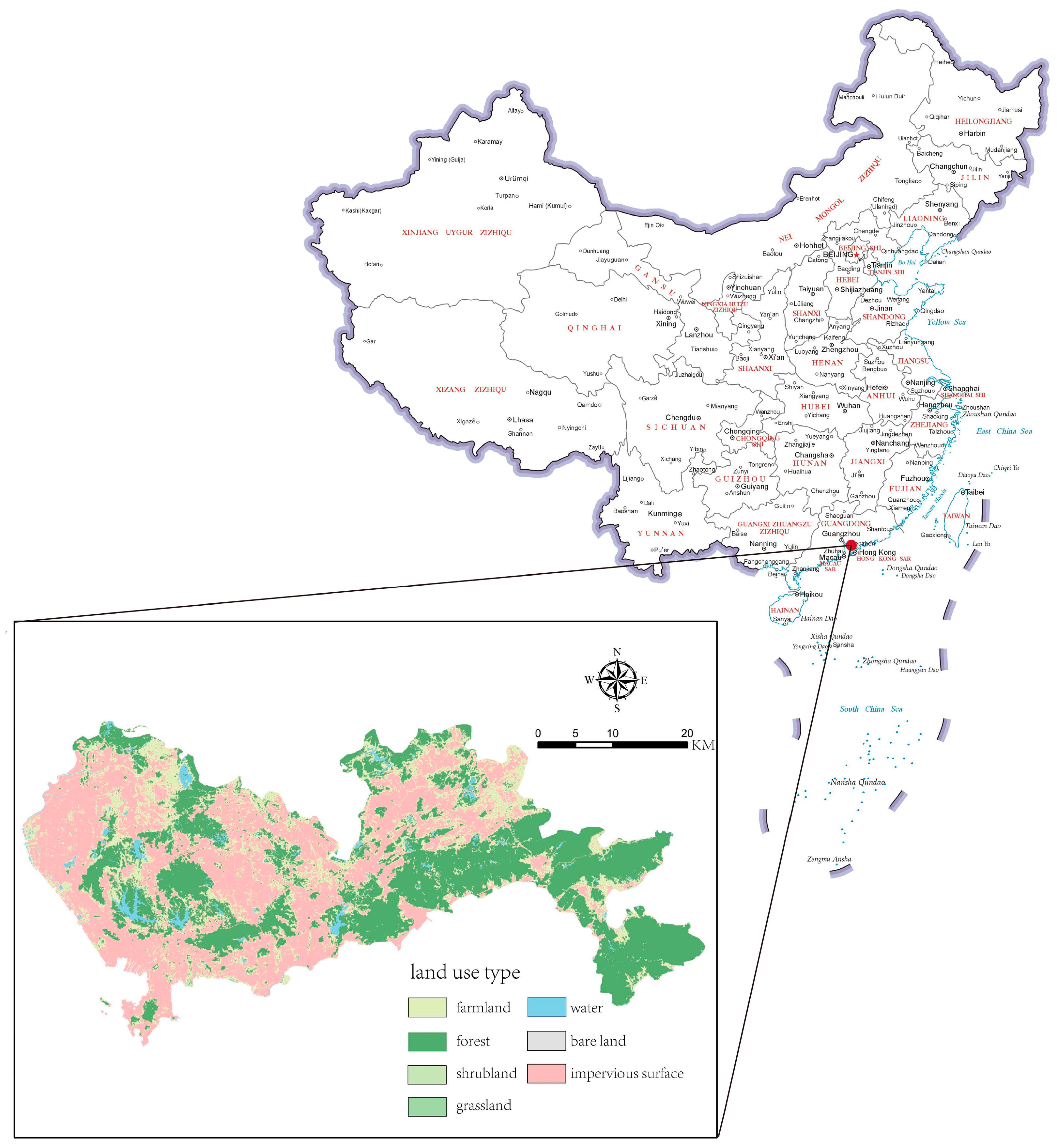
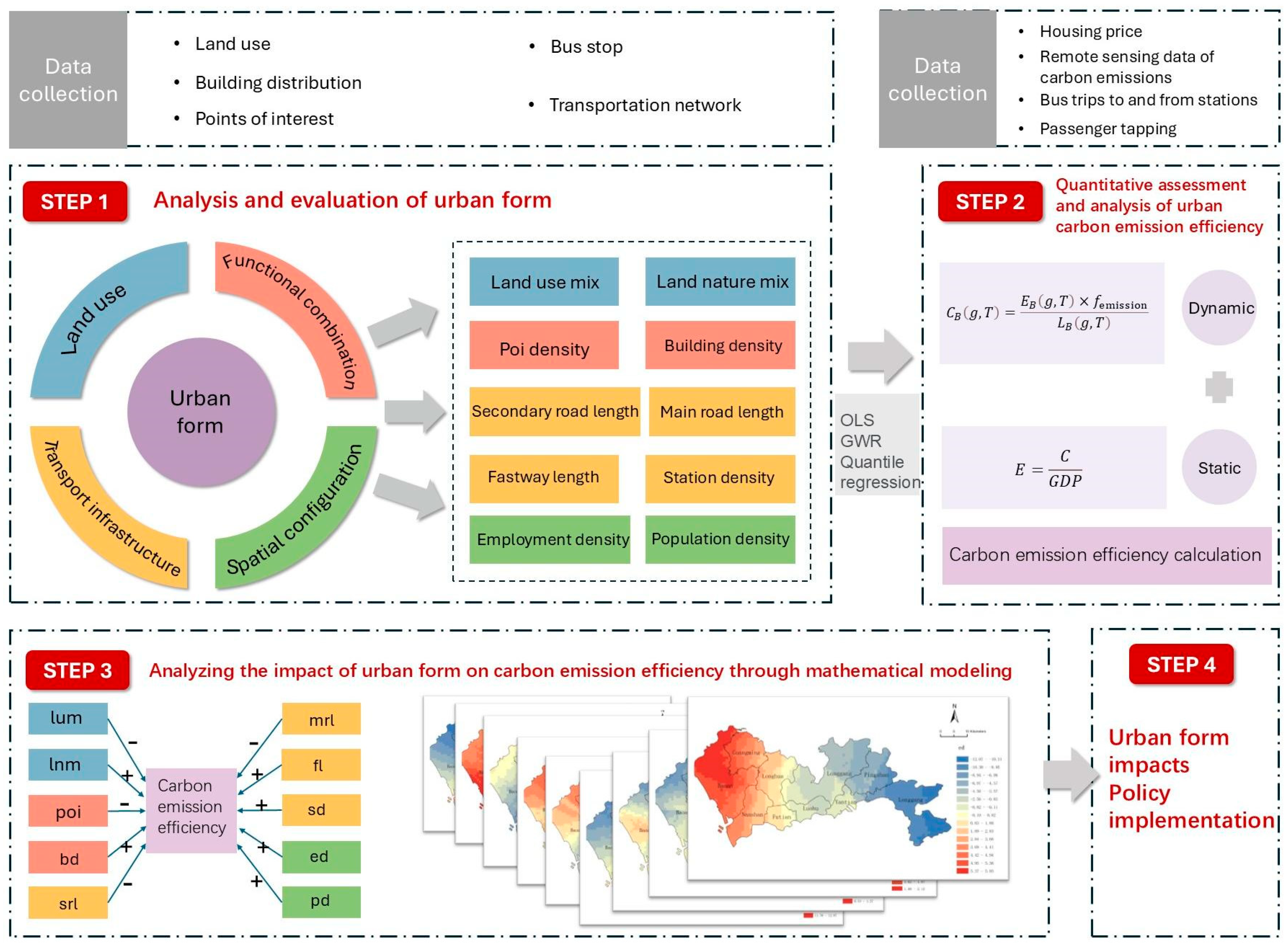
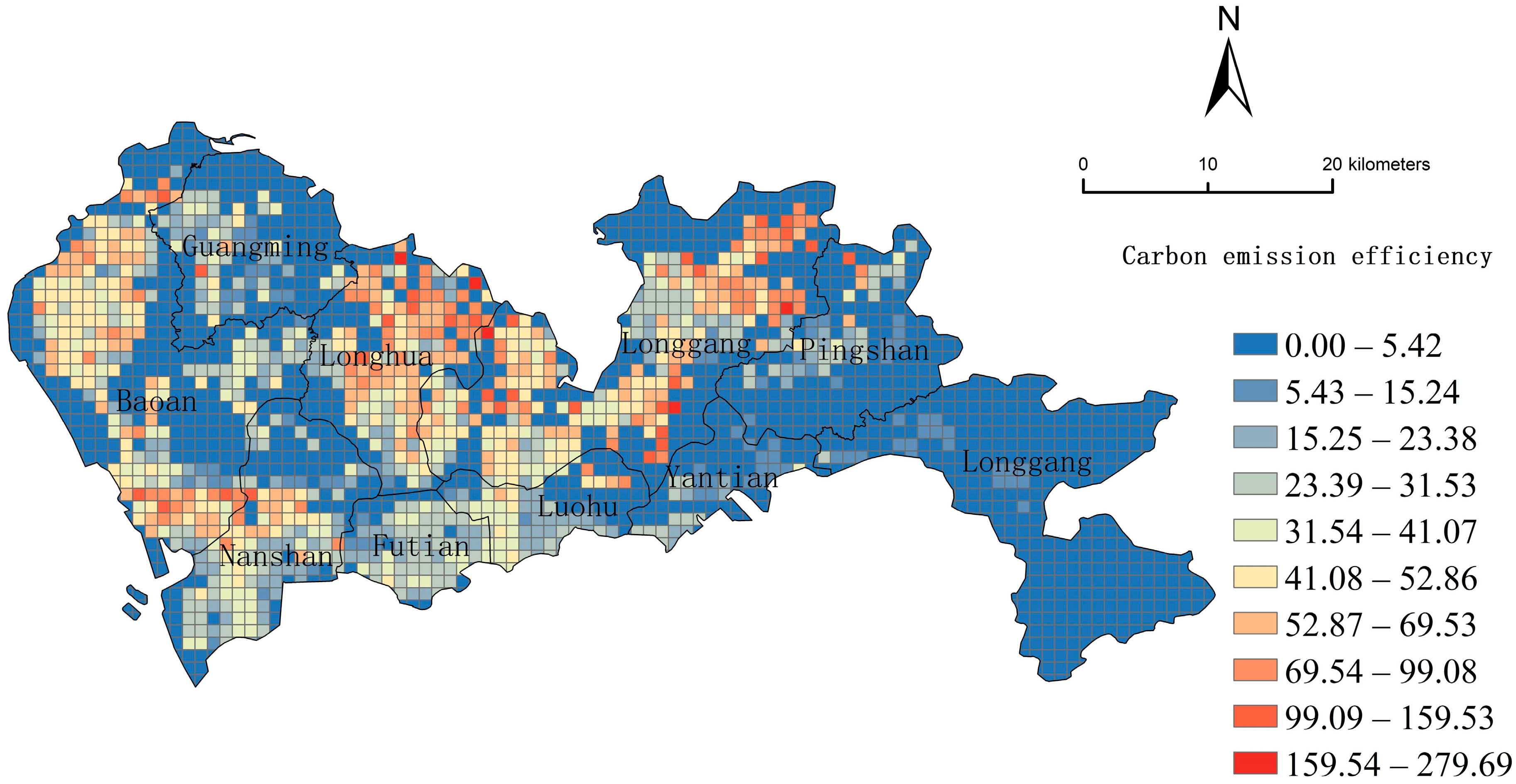

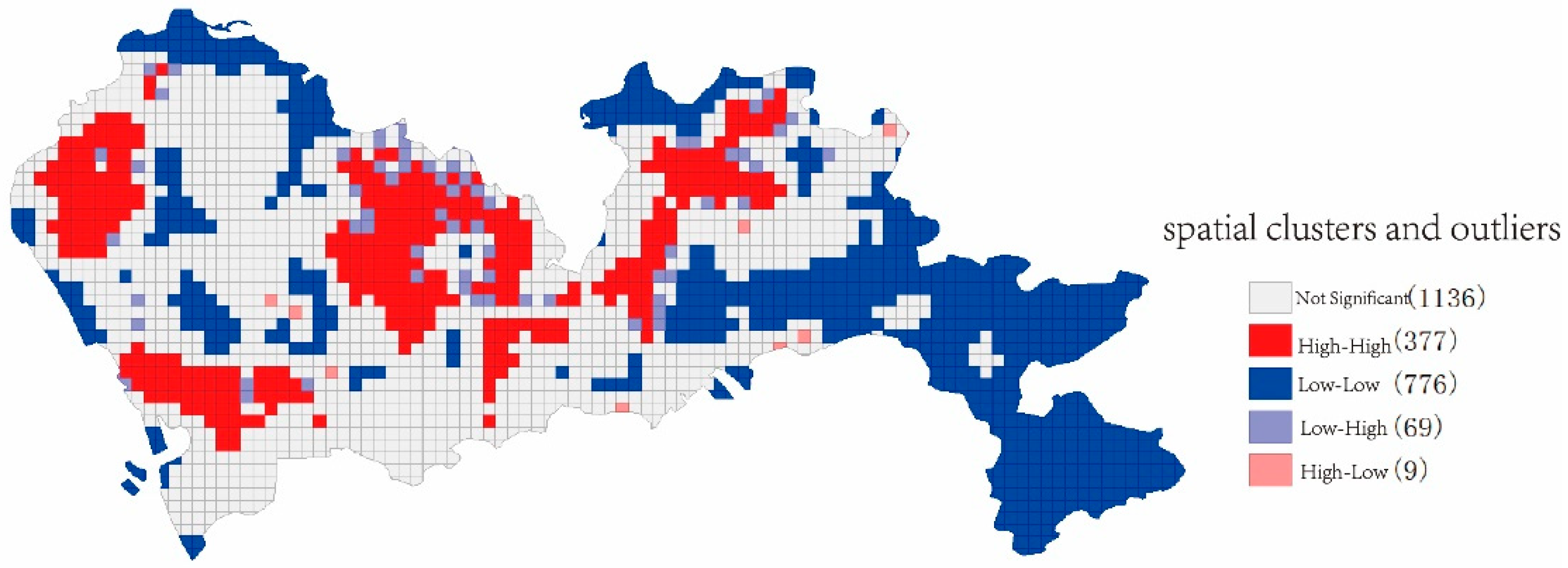
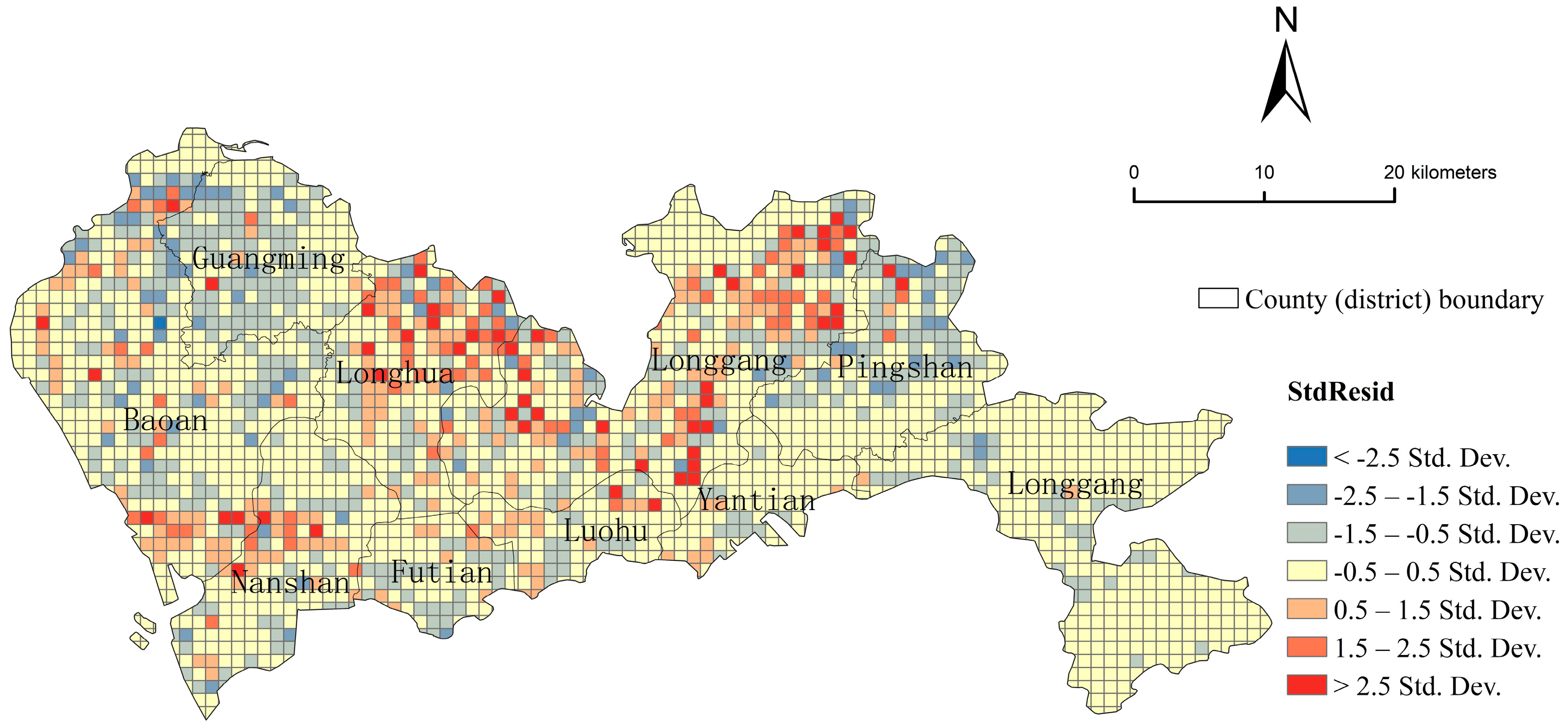

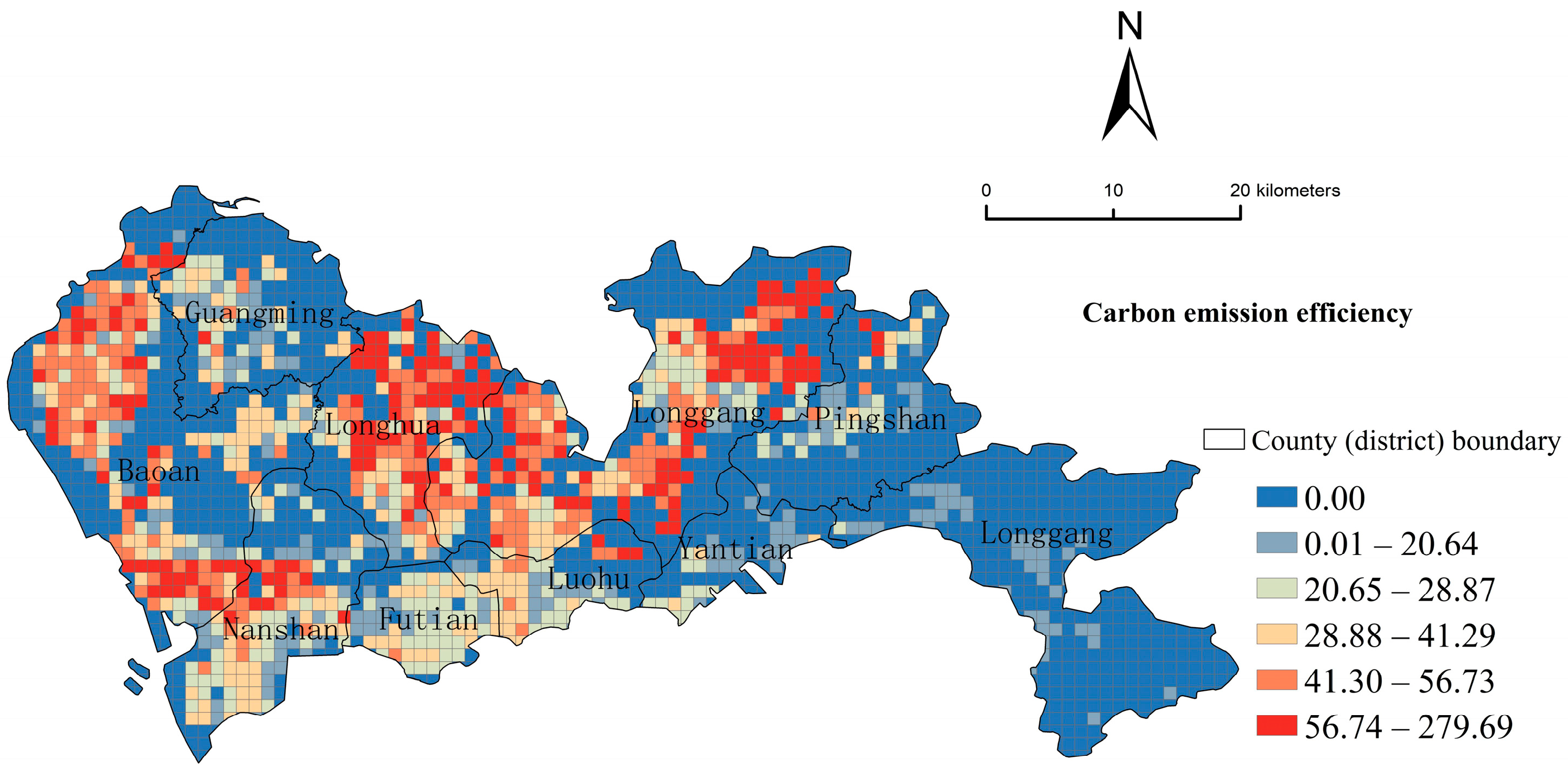
| Category | Elements | Calculation Instructions | Original Data | Data Source |
|---|---|---|---|---|
| Land use type | Land use mix (lum) | Measurement of the land use composition using the Shannon diversity index (SHDI) | 30 m land use data | GlobeLand30, NGCC, China |
| Land nature mix (lnm) | Measurement of the land use composition based on POI categories using the SHDI | POI data | Amap Open API Platform | |
| Functional mix | POI density (poi) | Total number of POIs within each unit grid | POI data | Amap Open API Platform |
| Building density (bd) | Total building area within each unit grid | Urban building data | OpenStreetMap (OSM) | |
| Transportation structure | Station density (sd) | Total number of public bus and metro stations within each unit grid | Urban bus and station data | Amap Open API Platform |
| Main road length (mrl) | Total length of the main roads within each unit grid | Urban road network data | Amap Open API Platform | |
| Secondary road length (srl) | Total length of secondary roads within each unit grid | Urban road network data | Amap Open API Platform | |
| Fastway length (fl) | Total length of expressways and highways within each unit grid | Urban road network data | Amap Open API Platform | |
| Spatial layout | Employment density (ed) | Total number of employees within each unit grid | Mobile signal data | China Mobile (CMO), PRC mobile operator |
| Population density (pd) | Total number of residents within each unit grid | Mobile signal data | China Mobile (CMO), PRC mobile operator | |
| Control variable | Mountainous area | If forest > 50% of grid area; 0 otherwise. | 30 m land use data | GlobeLand30, NGCC, China |
| Carbon Emission Efficiency | Coef. | p Value | |
|---|---|---|---|
| Land use mix | −0.047 | 0.003 *** | |
| Station density | 0.003 | 0.896 | |
| Secondary road length | −0.040 | 0.029 ** | |
| Land nature mix | 0.387 | 0 *** | |
| Main road length | −0.036 | 0.089 * | |
| Building density | 0.307 | 0 *** | |
| POI density | −0.129 | 0 *** | |
| Fastway length | 0.122 | 0.364 | |
| Employment density | 0.043 | 0.147 | |
| Population density | 0.135 | 0 *** | |
| Constant | 17.89 | 0 *** | |
| Mean dependent var. | 17.890 | Standard deviation dependent var. | 26.962 |
| R-squared value | 0.4518 | Number of observations | 2367 |
| F test | 199.008 | Prob. > F | 0.000 |
| Akaike information crit. (AIC) | 5320.938 | Bayesian information crit. (BIC) | 5364.178 |
| Variable | OLS | GWR | |||
|---|---|---|---|---|---|
| Coef. | Min. | Med. | Max. | Avg. | |
| Land use mix | −0.047 | −0.139 | −0.030 | 0.019 | −0.049 |
| Station density | 0.003 | −0.099 | −0.034 | 0.086 | −0.014 |
| Secondary road length | −0.040 | −0.072 | −0.030 | 0.060 | −0.017 |
| Land nature mix | 0.387 | 0.078 | 0.404 | 0.471 | 0.363 |
| Main road length | −0.036 | −0.095 | −0.023 | 0.085 | −0.024 |
| Building density | 0.307 | 0.109 | 0.267 | 0.488 | 0.275 |
| POI density | −0.129 | −0.224 | −0.116 | 0.045 | −0.102 |
| Fastway length | 0.122 | −0.031 | −0.002 | 0.079 | 0.013 |
| Employment density | 0.043 | −0.070 | 0.081 | 1.102 | 0.283 |
| Population density | 0.135 | −0.443 | −0.011 | 0.217 | −0.035 |
| R2 | 0.451 | 0.502 | |||
| AICc | 5320.938 | 5146.571 | |||
| Variable | Quantile | OLS | ||||
|---|---|---|---|---|---|---|
| (0.1) | (0.25) | (0.5) | (0.75) | (0.9) | ||
| Land use mix | −0.0131 | −0.0233 | −0.0113 | −0.0000262 | −0.00101 | −0.047 *** |
| (−1.93) | (−1.81) | (−0.85) | (−0.00) | (−0.03) | ||
| Station density | 0.0935 *** | 0.135 *** | 0.0465 * | −0.0233 | −0.164 ** | 0.003 |
| (8.06) | (6.15) | (2.05) | (−0.84) | (−3.07) | ||
| Secondary road length | −0.00122 | −0.000175 | −0.0187 | −0.0272 | −0.00657 | −0.040 ** |
| (−0.16) | (−0.01) | (−1.24) | (−1.46) | (−0.18) | ||
| Land nature mix | −0.0108 | 0.0328 | 0.264 *** | 0.437 *** | 0.649 *** | 0.387 *** |
| (−0.80) | (1.28) | (10.01) | (13.45) | (10.43) | ||
| Main road length | −0.0106 | −0.0179 | −0.00742 | −0.0160 | −0.00847 | −0.036 * |
| (−1.18) | (−1.06) | (−0.43) | (−0.74) | (−0.21) | ||
| Building density | −0.00626 | 0.0317 | 0.254 *** | 0.472 *** | 0.665 *** | 0.307 *** |
| (−0.50) | (1.35) | (10.51) | (15.84) | (11.65) | ||
| POI density | 0.0356 *** | −0.0283 | −0.0854 *** | −0.122 *** | −0.0992 * | −0.129 *** |
| (3.47) | (−1.46) | (−4.27) | (−4.95) | (−2.10) | ||
| Fastway length | −0.00639 | −0.00301 | −0.00382 | 0.00367 | 0.0723 * | 0.122 |
| (−0.98) | (−0.24) | (−0.30) | (0.23) | (2.40) | ||
| Employment density | −0.0953 *** | −0.0691 ** | 0.0142 | 0.0837** | 0.208 *** | 0.043 |
| (−7.49) | (−2.87) | (0.57) | (2.74) | (3.56) | ||
| Population density | 0.187 *** | 0.284 *** | 0.125 *** | 0.0357 | −0.0982 | 0.135 *** |
| (12.93) | (10.36) | (4.41) | (1.03) | (−1.47) | ||
| Constant | −0.572 *** | −0.423 *** | −0.0918 *** | 0.231 *** | 0.620 *** | 17.89 *** |
| (−89.80) | (−35.15) | (−7.40) | (15.12) | (21.17) | ||
| R-squared | 0.0598 | 0.1690 | 0.3959 | 0.4784 | 0.4359 | 0.451 |
Disclaimer/Publisher’s Note: The statements, opinions and data contained in all publications are solely those of the individual author(s) and contributor(s) and not of MDPI and/or the editor(s). MDPI and/or the editor(s) disclaim responsibility for any injury to people or property resulting from any ideas, methods, instructions or products referred to in the content. |
© 2025 by the authors. Licensee MDPI, Basel, Switzerland. This article is an open access article distributed under the terms and conditions of the Creative Commons Attribution (CC BY) license (https://creativecommons.org/licenses/by/4.0/).
Share and Cite
Li, X.; Zhang, C.; Pan, T.; Dong, X. The Impact of Urban Form on Carbon Emission Efficiency Under Public Transit-Oriented Development: Spatial Heterogeneity and Driving Forces. Land 2025, 14, 1172. https://doi.org/10.3390/land14061172
Li X, Zhang C, Pan T, Dong X. The Impact of Urban Form on Carbon Emission Efficiency Under Public Transit-Oriented Development: Spatial Heterogeneity and Driving Forces. Land. 2025; 14(6):1172. https://doi.org/10.3390/land14061172
Chicago/Turabian StyleLi, Xueyuan, Chun Zhang, Tianlu Pan, and Xuecai Dong. 2025. "The Impact of Urban Form on Carbon Emission Efficiency Under Public Transit-Oriented Development: Spatial Heterogeneity and Driving Forces" Land 14, no. 6: 1172. https://doi.org/10.3390/land14061172
APA StyleLi, X., Zhang, C., Pan, T., & Dong, X. (2025). The Impact of Urban Form on Carbon Emission Efficiency Under Public Transit-Oriented Development: Spatial Heterogeneity and Driving Forces. Land, 14(6), 1172. https://doi.org/10.3390/land14061172






